This DIY Mask Brace Will Make Your Face Mask Fit Better
To provide a better mask fit, the U.S. Centers for Disease Control and Prevention (CDC) is recommending the public use mask braces or fitters.
These devices are typically made of a pliable polymer, like silicone, and help your cloth or surgical masks fit more snugly on your face.
There aren't many mask braces available on Amazon—and you should watch out for inner-mask braces that promise to give you more space for breathing—but you can easily create your own.
When it comes to face masks, there are no true substitutes for professionally fitted N95 respirators, the gold standard in protection against COVID-19. But given the shortage of such equipment (first responders, doctors, and nurses rightfully get first dibs) and a lack of easily accessible fit tests for civilians, we've all had to get a bit creative with face masks.
➡ The Best N95 Respirators
You're likely familiar with double masking by now, but have you heard about the humble mask brace? It's an apparatus meant to turn your floppy, ill-fitting face mask into effective personal protective equipment. Think of this silicone mask brace like it's the tailor of the mask world.
✔ Pop Mech Pro: Get exclusive answers to your burning science questions.
Mask braces, also known as mask fitters, fall in line with a few other interventions, like nose wires and cord locks. These help to create a better seal around the sides of your face, where you can sometimes feel your warm breath escaping. As the U.S. Centers for Disease Control and Prevention (CDC) puts it:
"These devices can be used over a medical procedure mask or a cloth mask to improve the fit by helping to reduce air leakage from around the edges of the mask."
The best part: If you don't want to spend money on even more personal protective equipment—and you have a few spare parts lying around at home—you can cheaply make your own mask brace. We'll tell you what the science says and walk you through that DIY process.
How Do Mask Braces Work?
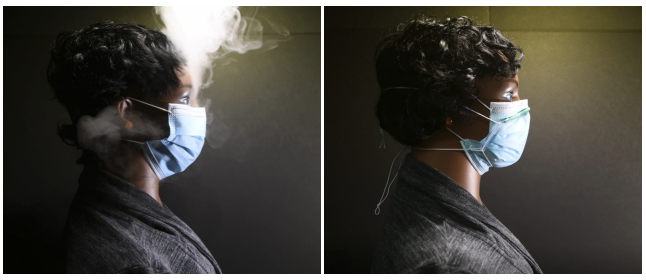
A 2020 study from Wake Forest Institute of Regenerative Medicine shows even the best surgical masks and cloth masks leave something to be desired when it comes to filtration efficiency. Surgical masks can filter up to 62 to 65 percent of particles that are 0.3 to 1.0 microns in diameter, while cloth masks made of thick, high-thread-count materials could filter up to 79 percent of the same size particles.
➡ The Best Surgical Masks
➡ The Best Cloth Masks
Those are pretty modest figures when you compare these face coverings to N95 and KN95 masks, which are rated to filter out 95 percent of particles, as their name suggests.
➡ The Best KN95 Respirators
To bring surgical and cloth masks up to par with N95s and KN95s, you can opt for a mask brace, which is an even better solution than double masking, says David Rothamer, a professor of mechanical engineering at the University of Wisconsin-Madison who has conducted work evaluating mask braces.
"It's kind of interesting that it's taken awhile for mask fitters or braces to have more visibility," Rothamer tells Popular Mechanics. "The whole double masking thing is really trying to do the same thing as a mask fitter or a brace, but in a more indirect way. My main concern with double masking is that it's going to depend on the combination of the two masks."
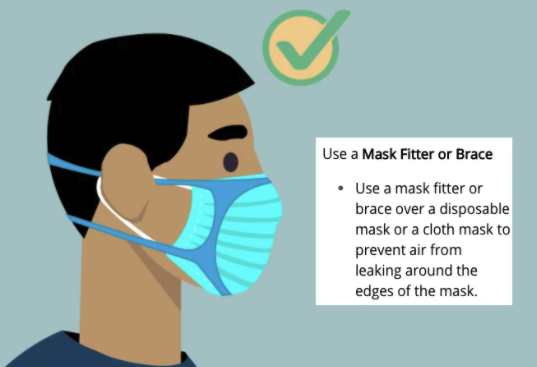
Plus, there's an added benefit to wearing a mask brace: A tight seal around the sides of the face covering will help keep your warm breath from escaping, which means no more foggy glasses.
But mask braces, which fit over the top of your surgical or cloth mask, aren't the same thing as the inner-mask support brackets you'll sometimes find on Amazon when searching for mask braces (see the image below). These devices claim to lift the mask off your mouth and nose, "allowing for more space for breathing." In some cases, the brackets are advertised with the added benefit of avoiding lipstick smudges, which will allow you to keep reusing masks longer.
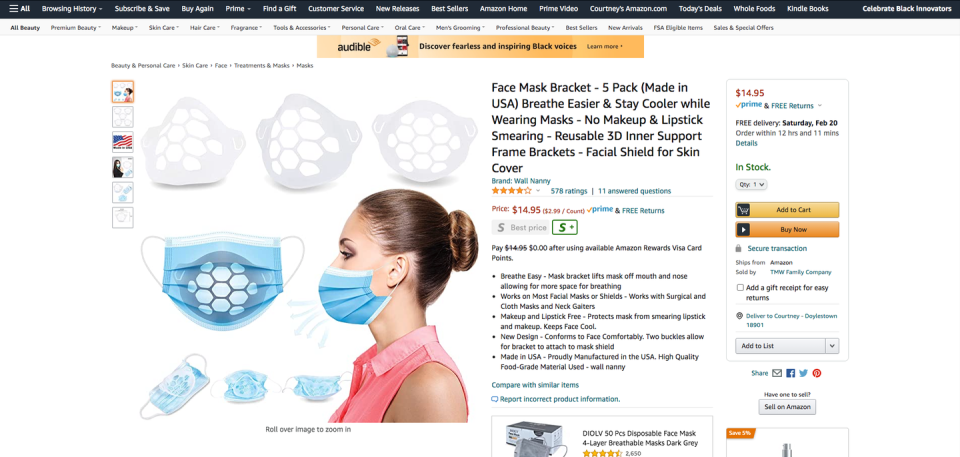
These brackets don't claim to create a better seal for your mask. In fact, they actually seem to promise the opposite. However, "no studies have looked at mask brackets and how they affect the transmission of the coronavirus or other infectious agents," Dr. Donald Dumford says in a Cleveland Clinic blog post.
And just because your mask doesn't have lipstick stains on it, that doesn't mean you should keep wearing the same mask for days on end.
How Do I Know If I Need a Mask Brace?
When your mask brace fits correctly, you should be able to create higher pressure levels inside your mask as you exhale (relative to the surrounding environment) causing the mask to expand outward, just like blowing into a balloon, Rothamer says.
Conduct this quick experiment to compare the seal of your mask with or without a brace: "Hold the mask up and to use your pointer fingers and thumbs to make a triangle, and see if [the mask] is comfortable to breathe through," Rothamer advises. This will create a seal and stimulate what a mask fitter feels like.
Compare this experience to regularly breathing through your mask. If it's significantly easier to breathe, or if you can feel more air escaping from the sides than when you placed your fingers over the mask in a triangle shape, you'll benefit from a better seal and should consider using a mask brace.
What Does the Science Say?
A few universities—including the University of Wisconsin-Madison, the University of North Carolina, and the University of Iowa—have produced white papers testing the effectiveness of mask braces. And they all came to a similar conclusion: they work.
Rothamer contributed to the University of Wisconsin-Madison preprint (that means the work has not yet been peer-reviewed), which published to the MedRxiv server in January. The paper shows most masks don't meet their peak filtration efficiency because they don't fit a user's face. Mask braces, the researchers say, "can substantially reduce aerosol emission when fit properly."
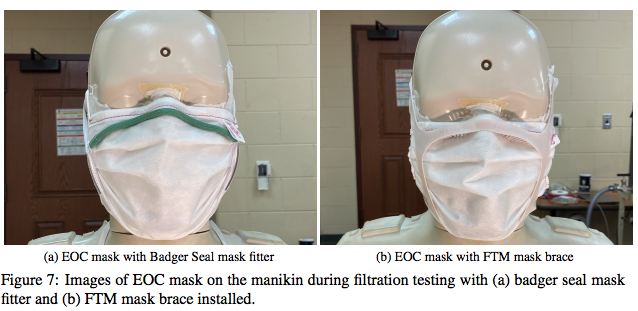
"As long as you're pushing the mask closer to your face, and you're not creating any new gaps that didn't exist before, [a mask] will generally fit better," Rothamer says. "In most cases, you'll be as good or better as you were without the mask brace."
Similarly, the University of Iowa study, published in December 2020 in the peer-reviewed Journal of the American College of Emergency Physicians Open, shows mask braces increase the effectiveness of masks.
In quantitative fit tests, using machinery designed to certify N95 mask fit, the researchers discovered that 45 percent, 100 percent, and 100 percent of the 11 subjects passed the fit test when the brace was anchored behind people's ears, with a paperclip, and on a face shield, respectively.
"This data suggests that although the brace does not create an N95 equivalent in terms of filtration, it would offer improved protection from airborne viruses when worn with a basic surgical mask," the scientists wrote.
Where Can I Buy Mask Braces?
Unlike N95 and KN95 masks, the CDC doesn't maintain a list of approved mask braces. That means governmental health agencies haven't evaluated the effectiveness of these devices, so you'll be buying at your own risk.
There aren't many options on Amazon right now, but we did find one from the manufacturer ETEERNVITY, which ships from China. It doesn't have any user reviews, so again, purchase at your own discretion.
One backup option: Buy direct from Fix the Mask, a company that designs and sells popular mask braces. Fix the Mask uses a "biocompatible silicone" (nontoxic, non-irritating rubber) in its braces.
Fix the Mask braces also feature patent-pending nose bristles that help the brace contour to your face without added pressure to help create a tight, yet comfortable seal. The braces come in three sizes (small, medium, and large), so you can find a proper fit for your nose. As of press time, Fix the Mask has passed the U.S. Department of Labor's Occupational Safety and Health Administration (OSHA) fit testing protocol over 60 times.
You could instead opt for a Badger Seal, an open source mask brace that scientists at the University of Wisconsin-Madison designed. By their measures, adding the Badger Seal to a 3-ply disposable mask reduces the effective particle penetration 15 times over.
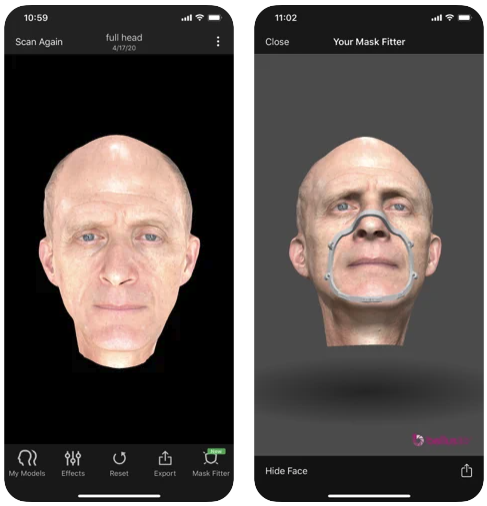
There's also Bellus3D Mask Fitter frame, a personalized, 3D-printed plastic frame that's custom-designed to contour to the shape of your face to improve the seal of the mask. According to the Bellus3D website, "the frame is automatically generated from a 3D face scan using the Bellus3D Face App or Dental Pro app for Apple iPhones or iPads with FaceID capability."
You can either 3D print the file yourself or use one of Bellus3D's fulfillment partners—including Master Laboratories, Kainos Dental Technologies, and Apex PPE—to print the mask brace.
How to Create Your Own DIY Mask Brace
Fix the Mask offers a DIY template for rubber mask braces free of charge (check out the video above for instructions), and the University of Wisconsin-Madison also provides instructions for how to create your own Badger Seal.
You'll need a few pieces of equipment, though. For the Fix the Mask model, you'll need a pair of scissors and a 1/32" Shore 40A rubber sheet (a 12-by-24 inch sheet is enough for five or six mask braces).
For each Badger Seal, you'll need micro cutters (or scissors in a pinch), a ruler, something with a point to help push the cord through the cord lock (like a paperclip or metal coat hanger), 6 inches of foam wire, 30 inches of elastic cord, 2.25 inches of 1/4-inch-thick PVC tubing, and a cord lock.
I forgot my cloth mask today, so it was a good day to try a mask brace for my backup surgical-type mask. A 🧵on making it and my impressions of it. /1 pic.twitter.com/dhGhEZsXBf
— Linsey Marr (@linseymarr) January 26, 2021
In January, Linsey Marr, an aerosol scientist at Virginia Tech who has expertise in airborne transmission of viruses, tried her hand at making the Fix the Mask model. In a thread on Twitter, she gave her review of the final product, calling it "very useful."
"It's tiny and lightweight, so I'll keep it with my backup surgical mask," she wrote. "Good for backup but I wouldn't want to wear it all day."
🎥 Now Watch This:
You Might Also Like

